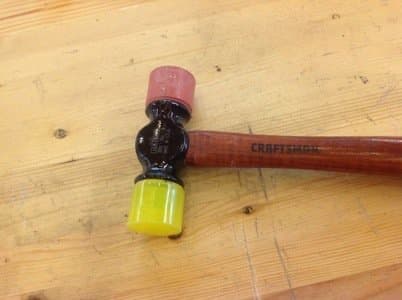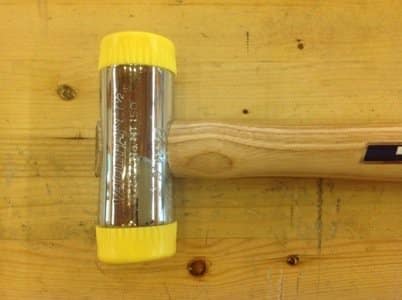Why not mallets – myths busted again!
Why did I revert to metal worker’s panel-beater hammers instead of traditional mallets?
It’s dead simple. My goal is not the preservation of the traditions but the craft. That my goal just happens to do both is a great coincidental for me, generally speaking, anyway. So the traditionalists cling to their traditions and exclude modern developments that are as equally inspired to us today as those were to men two and three hundred years ago when their ideas were innovative and new and rejected even as heresy.
I have used and still use wooden mallets in my immediate work. I like them for some work and find them unsuited to others. Modern day manufactured wooden mallets in general are wimpy and ill-designed apologies for what once was. My own hand-makes are not. I have yet to find a commercial mallet made in the last fifty years that wasn’t underweight and thereby none productive. Those touted and sold as beech mallets made in Europe are generally this type of mallet. That being so, making your own becomes the only option. A good mallet needs a 3″ x 4 1/2″ x 7″ head. Hard maple works well, Bois d arc (osage orange) and many others too. Where do you as a new woodworker find these sizes in suited woods. Not so easy. Now my goal, and not all people feel this way, is to get people to the bench working the wood and not encouraging them to buy my tools or anyone else’s I am in the pay of or to get them to become tool junkies and procrastinators spending too much time talking and admiring the new generation of guru followers. So, at the risk of criticism, I find things, alternatives, when necessary, that really work and then give out my unbiased results. This is not meant to be cute or clever or in any way controversial, but inevitably things can become controversial. There are excellent products out there made for every level of demand and price. That’s positive, I think. On the other hand people getting into woodworking need some guidance and if you open a tool catalog and see fifteen mallets to choose from, questions like, “Arghhh! Which one do I choose?” need some kind of definitive answer. That’s where I come in. I have used them all. Name a saw, a plane, a hammer, a chisel, a mallet, a gauge, a knife and I have used them at some time recent or past. So, in my quest to counter the culture group analytics, I present a simple alternative as an immediate solution to get stuff in the vise and made into projects. It works, and it has for the whole of my life. People don’t always like this offering but I do always listen and care about what people say and think if they are open and honest rather than snide. If they can persuade me differently I will shift and represent something better after I have considered the elements by which we at New Legacy evaluate tools and their worth for our audience. Back to hammers. Where possible I want something anyone anywhere can walk into a store to buy. In the case of chisel hammers, well, they have gotten somewhat fanciful through the years. Cutish too. It’s inevitable that makers and users want to create something with a distinctive, set-apart style to be admired. Go and try to buy a simple claw hammer and there are three zillion of them in Lowes and Home Depot. Gone are the old 16oz Stanley claws and so too many others. Ergonomics gone wild so we can beat a sixpenny nail in in one blow.
The hammers I have used over the months and years deliver the goods. Weight ratios and balance are more critical and so too the centre of percussion (COP) that provides economy of movement and power. I find that with large face mallets, new woodworkers seldom find the COP, which is often an outer corner and not dead centred in the mallet head. Getting it wrong tilts the mallet, glances the blow and frequently twists the chisel from its course, especially in say mortise holes for instance. On the other hand, the smaller heads hit squarely and more accurately for a reason I cannot give. Most of my students have no difficulty using what I now call chisel hammers to chop and chisel with. Most of my recommendations are available from any store and they cost mostly around $15 for a lifetime tool. I want what’s best for my readers and students. They know that I think.
In concluding.
I think everyone should make their own mallets. Make two or three for their own use as I have. Two of my sons have owned businesses making mallets that were highly prized. They find it well worth the effort. Someone could make a good living making hard maple mallets and a none fanciful model I received as a boy back in 65 when I made my first mallet




Paul,
Well said as always and I’m glad you don’t worry about saying anything that may be taken as controversial. There are too many people out there spouting off that theirs is the only way.
I’d be interested in seeing the mallet design as I’d quite like to make my own as I have a panel beaters hammer for the day in day out chopping.
For anyone reading this comment, Paul had since created a video series where he creates a traditional mallet.
He includes all of the angles and logic behind the design.
Do go watch and then build your own.
I found a large “hunk” of unknown but quite dense wood (maybe elm?) at my property. Not really a size useful for anything.
I used it to make a mallet and while it is probably not the most resilient or absolute best wood type I found it so satisfying to make something out of a piece of wood I truly found.
One of my first woodworking mentors made me turn my own mallet of Osage Orange as my first project under his guidance. He said once I turned Osage Orange from a rough limb to a mallet that everything else would seem a breeze in comparison. He was right. Most everything else seems like butter next to Osage Orange.
When he passed away, his widow gave me his old Lignum Vitae mallet. You can still pick up good LV mallets, if you know how to look for them. I pick them up for cheap at antique malls when they are mislabeled as potato mashers. For $5, I feel I have to “rescue” it, so… I’ve ended up with a small collection of them over the years. Probably need to thin them out, though.
Patrick,
You actually get good COP with round carving mallets once you get used to them. In actuality, carvers often use glance-blows to effect a scalloping cut say for the inside of a leaf or petal. That’s when round mallets come to their own.
Paul,
If making a round mallet, would a piece from a limb be any better? I seem to remember someone mentioning limbs are generally “tougher” than heart wood.
Hi guys,
Some great comments, I use a carvers mallet my self, but I believe in each to their own. Whatever feels right for you, is the way to go.
Hi Paul,
I’m using a Forge Steel mallet from Screwfix at the moment. I’ve just finished building my workbench (from your course) and a new mallet is something high on my list of priorities as my current one is all but destroyed after chopping mortises for the bench. You get what you pay for, I guess.
Now I’ve got my bench finished, I’d love to try making my own mallet. Could you send me the design you mentioned? I’ll try and find somewhere to get some maple and see how I get on.
George.
I’v found wood to be at a premium: 3/12 or 4 4/14 in a 6 or 7 inch length is q time consuming search. I’m looking for found wood that might be close enough, figuring that the worst case is that it’s capable or tapping or bashing, but I haven’t done any real mallot carving yet, so there will be things to discover and learn.
As far as a woodworking chisel mallet/hammer, interchangeable two headed should be good. I found a much less expensive four head hammer at Harbor Freight and combined with my father’s very old plastic headed hammer would give a good enough trial.
But what will happen when I have sculpting cuts to make in a Butterwood Gargoyle. Brass, wood, lignum Vitae — time will tell.
I have even consider raiding the wood pile for newly aging maple, cherry and Sycmamore. Can anyone give me a heads up on using mostly unseasoned wood to make a mallet that wiil have a joint and especially the hazards to myhead the firstfew times I swing it.
I as well am interested in receiving the design you mentioned so many years ago. If the offer still stands, I’d ask you to please send it to me.
As a note of caution I purchased a soft faced (plastic & rubber) hammer from the local big box store.
While the construction seems fine and will probably last a lifetime, the handle diameter is MASSIVE.
It is something I would expect on a 2lb sledge not a 12oz soft faced.
I will shape and correct, but just something to be aware of.
Yet again a manufacturer having no idea what they are producing.
I turned a carving mallet of Black Locust, my favourite wood. It’s great weight wise. I need to fitness the handle, It’s round and a little fat for my hands. Oval may be a bit more comfortable.
Not sure if `i would. If it’s too big just rechuck it and turn it down gradually until it feels right. Carving mallets are v different to joiner’s mallets where orientation of the head is governed more by the rectangular shape giving instant recognition of the head in relation to the handle. Carving mallets can be rotted to use different areas of resistance in the wood and to give ‘glancing’ blows to effect a particular blow and create the shape by that action.